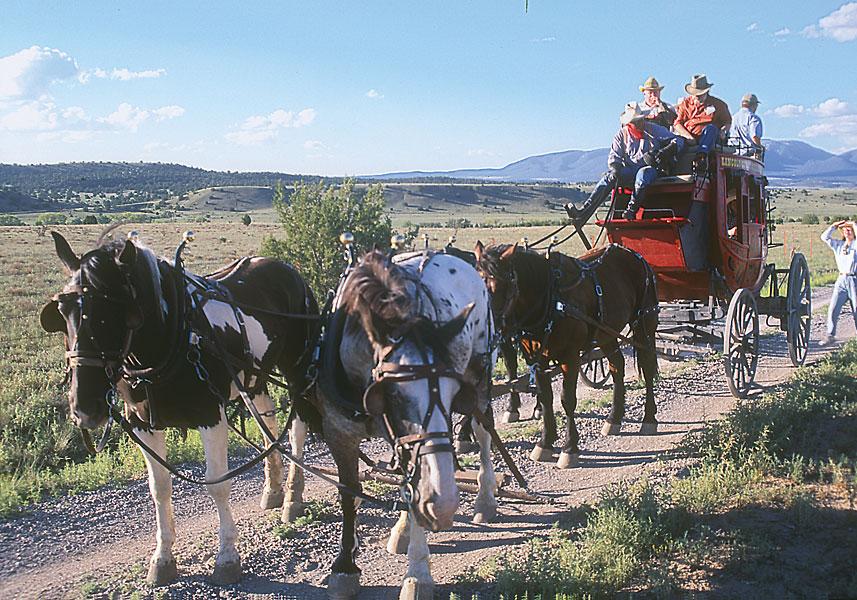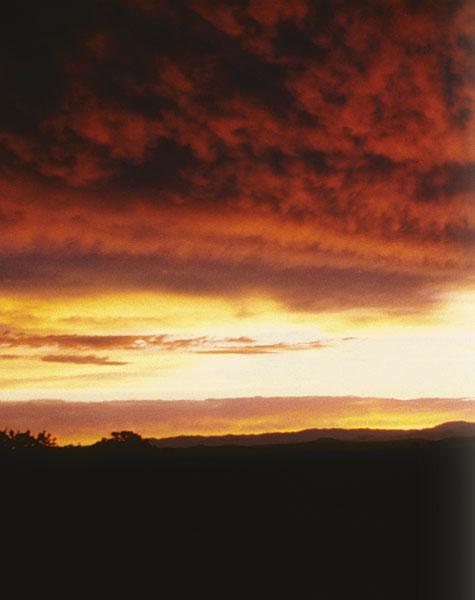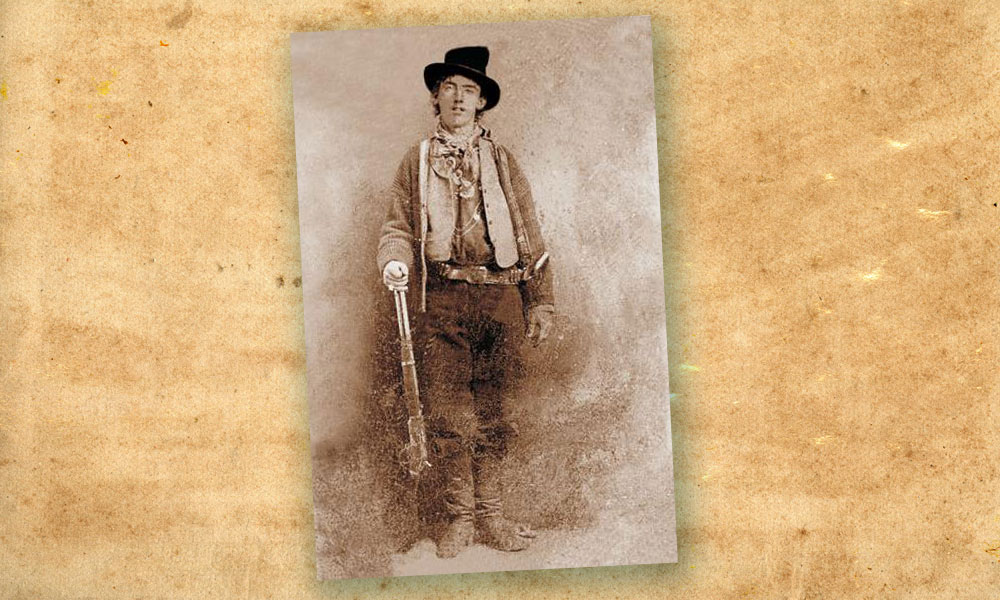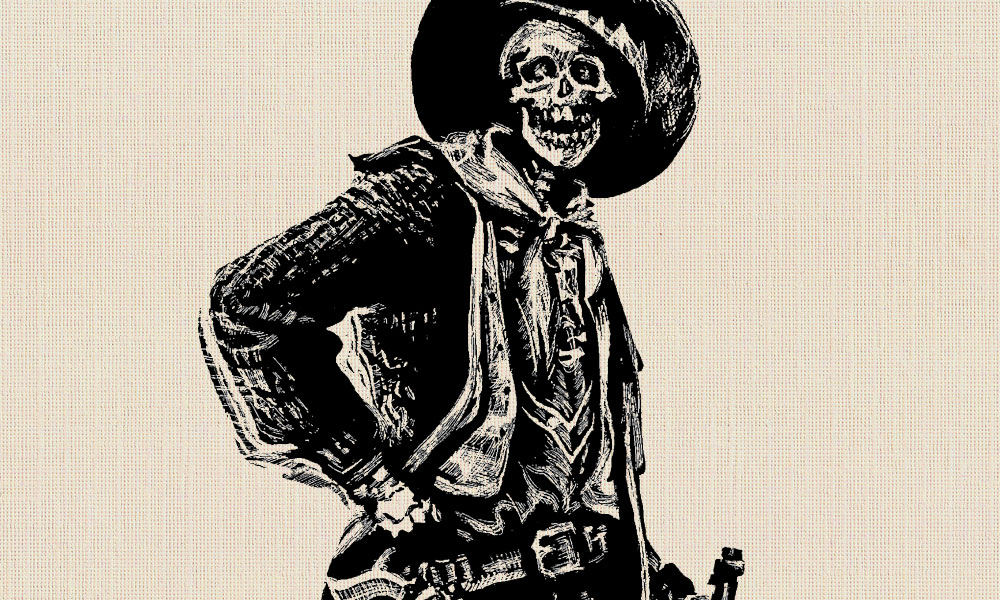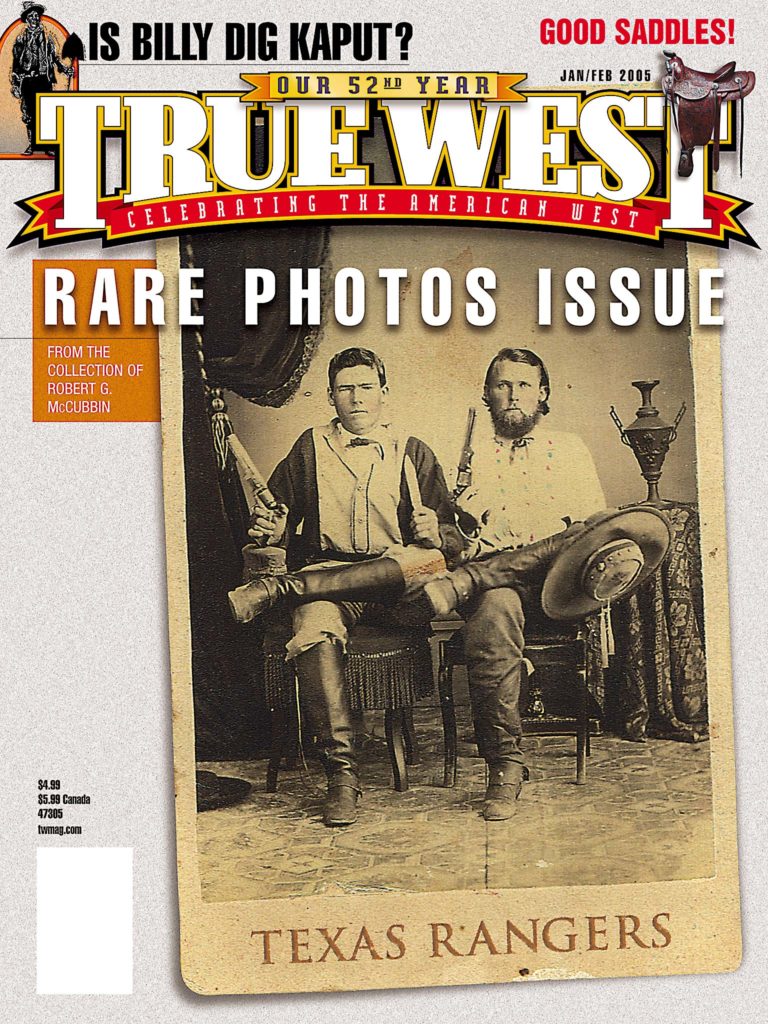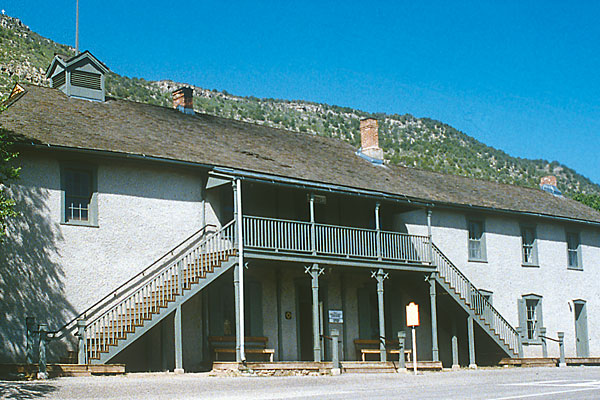 Rex Buchman says the mare I’m riding has been fed rocket fuel, but I don’t believe him. Besides, as our horses enter the Pecos River near Fort Sumner, New Mexico, my only concern is: Can she swim?
Rex Buchman says the mare I’m riding has been fed rocket fuel, but I don’t believe him. Besides, as our horses enter the Pecos River near Fort Sumner, New Mexico, my only concern is: Can she swim?
Buchman, a program director/agent with the DeBaca County Extension Service, and Tim T. Hagaman, who runs the Wortley Pat Garrett Hotel in historic Lincoln, created “The Trail of Billy’s Last Ride,” a 100-plus-mile butt-on experience from Lincoln to Fort Sumner, but I’m not part of that trail ride. This is just a nice way to wind down after a Renegade Road.
As my horse plunges into the river, I wonder if William H. Bonney ever entered the Pecos here. Fort Sumner’s the end of my journey, and splashing through the Pecos is a good time to reflect on Billy the Kid.
The Texas Connection
Of course, no one knows exactly where the Billy the Kid Trail really begins. New York? Indiana? Missouri? Wichita might be a good place to start, but you can’t get good Mexican food in Kansas, so let’s mount up in the Texas Panhandle.
A short drive out of Amarillo is Tascosa. The Kid frequented the “Cowboy Capital of the Plains” during his rustling days, but today Old Tascosa is known for Cal Farley’s Boys Ranch, a home for wayward boys and girls, established in 1939. Boys and girls maintain Tascosa’s Boot Hill Cemetery and Julian Bivins Museum, and visitors are welcome at the ranch, open daily from 8 a.m. to 5 p.m.
It’s a shame the Kid came along too early. The late Mr. Farley, I bet, would have straightened that boy out.
Entering New Mexico
The Kid is mostly a New Mexico story, so drive east on I-40 to Santa Rosa. Girls from Santa Rosa, as well as nearby Puerto de Luna and Anton Chico, used to head down to Fort Sumner for weekly dances ’cause everyone knew the Kid could cut a rug with the best of them. Santa Rosa is more Route 66 than Billy the Kid today, but he would have coveted that restored Ford Mustang on display at James “Bozo” Cordova’s Route 66 Auto Museum. Hey, the Kid had an eye for horse flesh, and you gotta love a “Pony” interior.
On the other hand, Puerto de Luna, a short drive south, and Anton Chico, northwest off U.S. 84, haven’t changed much since the Kid’s day. Locals give strangers “the stare,” making sure they aren’t up to no good. Easy, pard, I’m just interested in photographing the church at Anton Chico, where Pat Garrett and Sallie Chisum got hitched (not to each other).
The Other Las Vegas
I get a much warmer reception in Las Vegas, at least better than the one Garrett received after hauling the Kid and his cronies, including Dave Rudabaugh, here in December 1880. Not that the locals were disenfranchised with the Kid, mind you. That legendary notice to several “thieves, thugs, fakirs and bunko-steerers,” warning them of a possible “neck-tie party,” was first printed in 1882, after the Kid’s death. That hasn’t stopped profiteers, however, from changing the year to 1881 and selling it as a William H. Bonney souvenir.
Anyway, in 1880 Las Vegas residents wanted to string up Dirty Dave, but Garrett managed to get his prisoners out of town safe and sound to Santa Fe.
You’re probably in a hurry to go to Santa Fe, too, but enjoy Vegas. It’s not Sin City, but the historic Bridge Street district, Las Vegas City Museum and Rough Riders Memorial are fun spots to visit before traveling south on I-25.
The City Different
The Kid spent early 1881 in the Santa Fe city jail (now a parking lot), writing Gov. Lew Wallace (be sure to visit the Palace of the Governors) before being sent south in late March, but this wasn’t the Kid’s first visit to the City Different.
His ma, the widowed Catherine McCarty, married William Henry Harrison Antrim at the First Presbyterian Church on March 1, 1873, and Billy and brother Joe were witnesses. The church is undergoing renovation, but I know if First Prez’s Sheila Gustafason had been preaching in the 1870s, she would have steered our misguided youth down a proper course.
Not only that, but Wendy Lane at Back at the Ranch would have put better boots on our boy than the Hessian-style pair he’s wearing in the historic photograph, and the friendly staff at the Bobcat Bite (best green chile cheeseburgers in the world) would have put meat on his bones.
Southern Sites
From Santa Fe, it’s a long, dusty trail down I-25 to Las Cruces, the end of the trail for Pat Garrett, who met his demise in Alameda Arroyo in 1908. The one-time Lincoln County sheriff is buried in the Masonic cemetery on Compress Road. Nearby is the marker for Albert Jennings Fountain, one of Billy’s attorneys. Fountain’s body, however, was never found after he and his youngest son were murdered in 1896.
One of Las Cruces’ biggest attractions is the 47-acre New Mexico Farm and Ranch Heritage Museum. Each October, the museum plays host to Cowboy Days, which showcases all things cowboy, but the museum’s worth visiting any time.
So is Old Mesilla. Once the gateway to Southern New Mexico, the village is now a charming tourist destination. The Plaza’s full of buildings on the National Historic Register, including the Billy the Kid Gift Shop. It was here in April 1881 that the Kid was tried and convicted of murdering Sheriff William Brady during the Lincoln County War. It was here that Judge Warren Bristol sentenced our boy to hang in Lincoln. And it was just across the street that I washed down spicy enchiladas with a tasty cranberry margarita at La Posta de Mesilla.
But Billy didn’t make a name for himself in Mesilla. It’s time to visit Lincoln County.
Lincoln and vicinity
Not much has changed in Lincoln since the 1870s. The street (that’s right, one street) is no longer dirt, but unlike too many Western villages, history has not been paved over in Lincoln, now a state monument.
Although you can spend the night in Lincoln, I opt to stay in Ruidoso. The accommodations at Apache Village Cabins are much better than John Henry Tunstall had at his ranch (despite what you see in movies), and Ruidoso makes a fine base camp for exploring Billy’s old haunts: Blazer’s Mill, Fort Stanton, San Patricio, White Oaks and the site of Tunstall’s murder in February 1878, which sent Billy on the road to legend. Ruidoso’s also a short drive to Capitan, home of Lincoln County’s one true hero.
When you get right down to it, the folks involved in the Lincoln County War—Tunstall, Billy, Alexander McSween, John Chisum, et al, on one hand; Lawrence Murphy, Jessie Evans, James Dolan, et al, on the other—had reputations that smelled like dead skunks. But no one ever says anything bad about Smokey Bear, and Smokey Bear State Park, the final resting place of the symbol for fire prevention, pays tribute to that great bear.
The home of the first million-dollar horse race, Ruidoso Downs, is also home to the Billy the Kid National Scenic Byway Visitors Center and Hubbard Museum of the American West, while Ruidoso’s Misty Mountain Gourmet Shoppe is the birthplace of Billy the Kid Coffee.
Lincoln’s the place for Billy buffs, though. Visitors can tour many buildings, including Tunstall’s store and the Torreon. At the museum and gift shop, they can learn about the five-day battle where McSween bought it in 1878. Outside the Lincoln County Courthouse (formerly, the Murphy-Dolan store), they can see where the Kid killed Deputies James Bell and Bob Olinger during his daring escape on April 28, 1881.
Just keep this in mind: While Lincoln isn’t as violent as it once was, that courthouse floor can be murder.
Trail’s End
From Lincoln, head east on U.S. 380 and then U.S. 70 past Roswell to Portales. Another Billy hangout, Portales isn’t just peanuts and windmills (as in, “Peanut Capital of the World” and the Dalley Windmill Collection). Check out the local museums (Roosevelt County, Blackwater Draw, Natural History) before making your way to Clovis and heading west on U.S. 60/84 to the end of the trail.
In December 1880, Garrett’s posse captured Billy and pals at Stinking Springs, near Taiban, and killed Charles Bowdre. The prisoners were first brought to Fort Sumner, my final stop.
After escaping the Lincoln jail in April, the Kid made his way back to Fort Sumner. On July 14, 1881, Garrett caught up and shot him dead. William Henry McCarty, alias William H. Bonney, alias Billy the Kid, alias ad nauseam, was planted alongside pseudo-pals Bowdre and Tom O’Folliard.
Fort Sumner’s full of Billy sites: Old Fort Sumner Museum, Billy’s Grave and the Billy the Kid Museum. Not much remains of the old military post, but visit the Fort Sumner State Monument not for Billy—Pete Maxwell’s house, where Billy died, is long gone—but to honor the memory of the tragic plight of the Navajo, interred here from 1864-68 at the miserable Bosque Redondo Reservation.
Which brings us back to my horseback ride. We’re out of the river now, admiring cottonwoods, but Billy’s still on my brain. Most accounts say Garrett killed the Kid in Maxwell’s bedroom. The poor boy only wanted to carve beef from a butchered yearling hanging on the porch.
Fool kid. He should have gone to Sprout’s Cafe for supper.
Johnny D. Boggs covered much of the Billy the Kid Trail while researching his 2004 novel, Law of the Land: The Trial of Billy the Kid, published by Signet.
Photo Gallery
– Courtesy Robert G. McCubbin –
Beneath New Mexico’s glorious sunsets, somewhere in the Capitan Mountains, you may come upon the legendary oak tree where Billy the Kid supposedly hid his weapons after his 1881 jail break.
– All photos by Johnny D. Boggs except otherwise noted –






